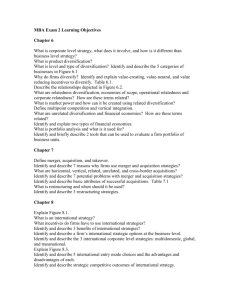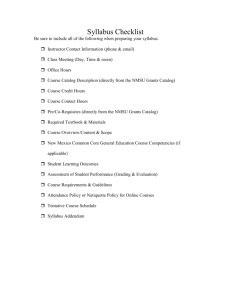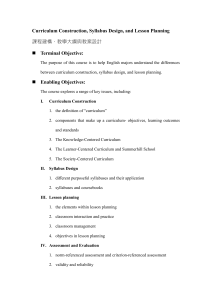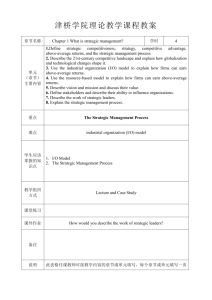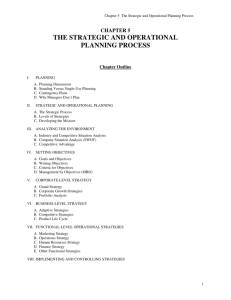índice de sílabus (abet) - Facultad de Ciencias Sociales y
advertisement
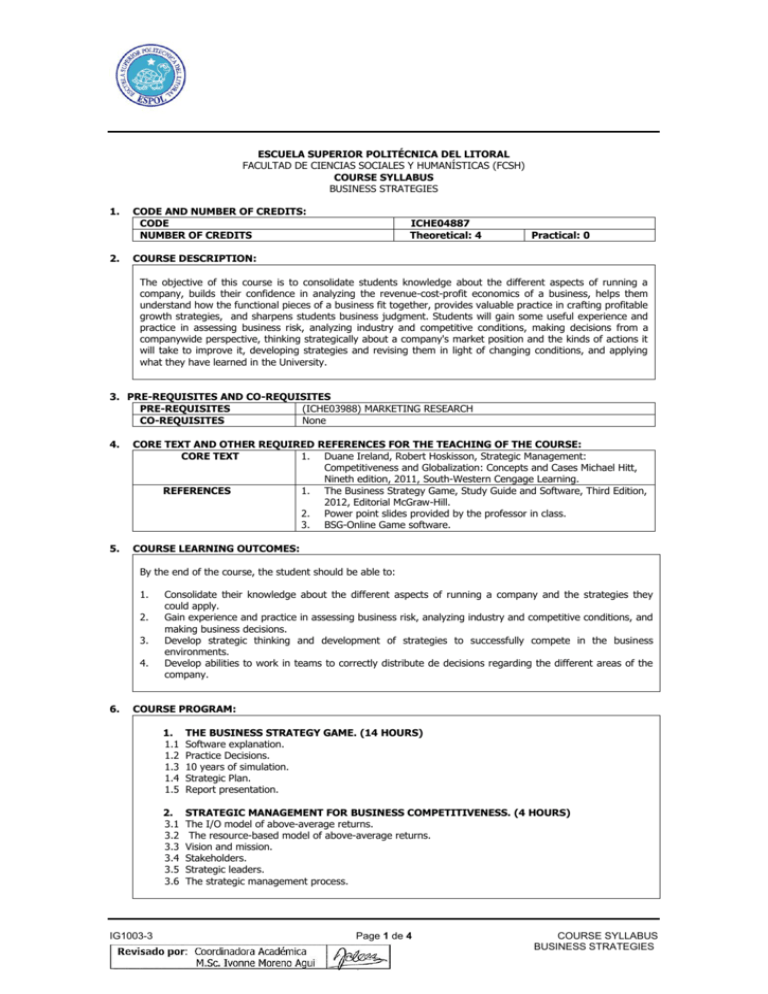
ESCUELA SUPERIOR POLITÉCNICA DEL LITORAL FACULTAD DE CIENCIAS SOCIALES Y HUMANÍSTICAS (FCSH) COURSE SYLLABUS BUSINESS STRATEGIES 1. 2. CODE AND NUMBER OF CREDITS: CODE NUMBER OF CREDITS ICHE04887 Theoretical: 4 Practical: 0 COURSE DESCRIPTION: The objective of this course is to consolidate students knowledge about the different aspects of running a company, builds their confidence in analyzing the revenue-cost-profit economics of a business, helps them understand how the functional pieces of a business fit together, provides valuable practice in crafting profitable growth strategies, and sharpens students business judgment. Students will gain some useful experience and practice in assessing business risk, analyzing industry and competitive conditions, making decisions from a companywide perspective, thinking strategically about a company's market position and the kinds of actions it will take to improve it, developing strategies and revising them in light of changing conditions, and applying what they have learned in the University. 3. PRE-REQUISITES AND CO-REQUISITES PRE-REQUISITES (ICHE03988) MARKETING RESEARCH CO-REQUISITES None 4. CORE TEXT AND OTHER REQUIRED REFERENCES FOR THE TEACHING OF THE COURSE: CORE TEXT 1. Duane Ireland, Robert Hoskisson, Strategic Management: Competitiveness and Globalization: Concepts and Cases Michael Hitt, Nineth edition, 2011, South-Western Cengage Learning. REFERENCES 1. The Business Strategy Game, Study Guide and Software, Third Edition, 2012, Editorial McGraw-Hill. 2. Power point slides provided by the professor in class. 3. BSG-Online Game software. 5. COURSE LEARNING OUTCOMES: By the end of the course, the student should be able to: 1. 2. 3. 4. 6. Consolidate their knowledge about the different aspects of running a company and the strategies they could apply. Gain experience and practice in assessing business risk, analyzing industry and competitive conditions, and making business decisions. Develop strategic thinking and development of strategies to successfully compete in the business environments. Develop abilities to work in teams to correctly distribute de decisions regarding the different areas of the company. COURSE PROGRAM: IG1003-3 1. 1.1 1.2 1.3 1.4 1.5 THE BUSINESS STRATEGY GAME. (14 HOURS) Software explanation. Practice Decisions. 10 years of simulation. Strategic Plan. Report presentation. 2. 3.1 3.2 3.3 3.4 3.5 3.6 STRATEGIC MANAGEMENT FOR BUSINESS COMPETITIVENESS. (4 HOURS) The I/O model of above-average returns. The resource-based model of above-average returns. Vision and mission. Stakeholders. Strategic leaders. The strategic management process. Page 1 de 4 COURSE SYLLABUS BUSINESS STRATEGIES 3. 3.1 3.2 3.3 3.4 3.5 3.6 THE EXTERNAL ENVIRONMENT FOR BUSINESS. (4 HOURS) The general, industry, and competitor environments. External environmental analysis. Segments of the general environment. Industry environment analysis. Strategic focus. Strategic groups. 4. 4.1 4.2 4.3 4.4 4.5 THE INTERNAL ENVIRONMENT FOR BUSINESS. (4 HOURS) The nature of internal environmental analysis. Resources, capabilities, and core competencies. Building core competencies. Outsourcing. Competencies, strengths, weaknesses, and strategic decisions. 5. 5.1 5.2 5.3 5.4 5.5 5.6 BUSINESS LEVEL STRATEGY. (4 HOURS) Effectively managing relationships with customers. The purpose of a business-level strategy. Types of business-level strategies. Differentiation strategy. Focus strategies. Integrated cost leadership/differentiation strategy. 6. 6.1 6.2 6.3 6.4 COMPETITIVE RIVALRY AND COMPETITIVE DYNAMICS. (4 HOURS) A model of competitive rivalry. Competitor analysis. Drivers of competitive actions and responses. Competitive dynamics. 7. 7.1 7.2 7.3 7.4 CORPORATE LEVEL STRATEGY. (4 HOURS) Levels of diversification. Reasons for diversification. Value-Creating Diversification: Related constrained and related linked. Unrelated diversification. 8. 8.1 8.2 8.3 8.4 8.5 ACQUISITION AND RESTRUCTURING STRATEGY. (4 HOURS) The popularity of merger and acquisition strategies. Reasons for acquisitions. Problems in achieving acquisition success. Effective acquisitions. Restructuring. 9. 9.1 9.2 9.3 9.4 9.5 9.6 INTERNATIONAL STRATEGY. (4 HOURS) Identifying international opportunities: incentives to use an international strategy. International strategies. Environmental trends. Choice of international entry mode. Strategic competitiveness outcomes. Risks in an international environment. 10. COOPERATIVE STRATEGY. (4 HOURS) 10.1 Strategic alliances as a primary type of cooperative strategy. 10.2 International cooperative strategy. 10.3 Network cooperative strategy. 10.4 Competitive risks with cooperative strategies. 11. ORGANIZATIONAL STRUCTURE AND CONTROLS. (4 HOURS) 11.1 Organizational structure and controls. 11.2 Relationships between strategy and structure. 11.3 Evolutionary patterns of strategy and organizational structure. 11.4 Implementing business-level cooperative strategies. 11.5 Implementing corporate-level cooperative strategies. 11.6 Implementing international cooperative strategies. IG1003-3 Page 2 de 4 COURSE SYLLABUS BUSINESS STRATEGIES 12. STRATEGIC LEADERSHIP. (2 HOURS) 12.1 Strategic leadership and style. 12.2 The role of top-level managers. 12.3 Managerial succession. 12.4 Key strategic leadership actions. 7. WORKLOAD: THEORY/PRACTICE: Sessions per week: 2 sessions Sessions length: 2 hours Weeks per semester: 14 weeks 8. CONTRIBUTION OF THE COURSE TO THE EDUCATION OF THE STUDENT: Students will gain some useful experience and practice in assessing business risk, analyzing industry and competitive conditions, making decisions from a companywide perspective, thinking strategically about a company's market position and the kinds of actions it will take to improve it, developing strategies and revising them in light of changing conditions, and applying what they have learned in the University. BASIC TRAINING PROFESSIONAL TRAINING SOCIAL SKILLS DEVELOPMENT X 9. THE RELATIONSHIP BETWEEN THE LEARNING OUTCOMES OF THE COURSE AND THE LEARNING OUTCOMES OF THE DEGREE PROGRAM: LEARNING OUTCOMES OF THE DEGREE PROGRAM* CONTRIBUTION (High, Medium, Low) a) Have the ability to work as part of a multidisciplinary team; MEDIUM b) Understand the ethical and professional responsibility; MEDIUM c) Have the ability to communicate effectively in Spanish both orally and in writing; d) Have the ability to communicate effectively in English; e) Having a broad education to understand the impact of the solutions of their career in the global, economic, environmental and social context; f) Recognize the need to continue learning throughout life and have the ability and attitude to do it; g) Understand issues; IG1003-3 contemporary LEARNING OUTCOMES OF THE COURSE** 4 1, 3, 4 THE STUDENT MUST: Having a good level of organization and teamwork. Understand the importance of moral and ethical behavior at all times while operating their virtual companies, duties and delivery of lessons. LOW MEDIUM 1, 2, 3 Write and write well homework, workshops, exams, and also have a good level of English to manage the BSG Online. LOW MEDIUM 1, 2, 3 Recognize that business strategies to be applied will depend on the environment and the type of organization where she works. LOW Page 3 de 4 COURSE SYLLABUS BUSINESS STRATEGIES h) Have the ability to lead and undertake; i) Apply analytical tools to assist in the evaluation and efficient management of financial, human and technological companies in order to project internationally; j) Analyze the economic environment and recommend business strategies and long-term to add competitiveness to the company in the domestic and international markets; k) Develop and evaluate export and import projects that contribute to the economic development of the company and the country, looking to fulfill corporate social responsibility. MEDIUM Having a good organization for the proper performance of their virtual businesses. 3, 4 MEDIUM Propose strategies to optimize resources to gain competitive advantage in the market for BSG Online. 1, 2, 3 HIGH Propose strategies to gain competitive advantage in the market for BSG Online. 1, 2, 3 HIGH Propose strategies for the proper performance of virtual enterprises and the correct sale and distribution of products in different markets. 1, 2, 3 (* This column must also include the common curricular outcomes (cross-curricular outcomes) that the institution approved on 16th February 2012 via resolution CP 12-02-078 of 23rd February 2012 (CAc-2012-034)) (** Only the NUMBER corresponding to section 5 of this document must be written.) 10. EVALUATION IN THE COURSE: Evaluation activities Exams Tests Homework/tasks Projects Laboratory/Experiments Class participation Visits Other X X X X X 11. PERSON RESPONSIBLE FOR THE CREATION OF THE SYLLABUS AND THE DATE OF ITS CREATION Created by EC. MARÍA CECILIA MORENO Date NOVEMBER/2012 12. APPROVAL: ACADEMIC SECRETARY OF THE ACADEMIC DEPARTMENT NAME: Lcda. Ingrid León Vasconez SIGNATURE: DIRECTOR OF TECHNICAL ACADEMIC SECRETARY NAME: MSc. Marcos Mendoza Vélez. SIGNATURE: Date of approval by the Directive Council: R-CD-FEN- 004-2013 January 14, 2013 13. VALIDITY OF THE SYLLABUS: RESOLUTION OF THE POLYTECHNIC BOARD: 13-10-269 DATE: IG1003-3 October 17, 2013 Page 4 de 4 COURSE SYLLABUS BUSINESS STRATEGIES



